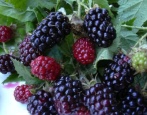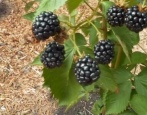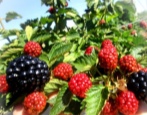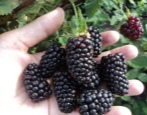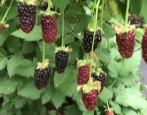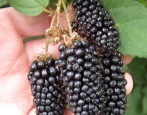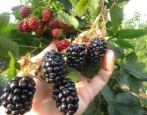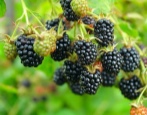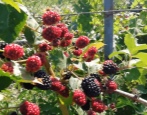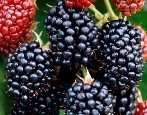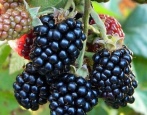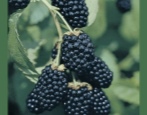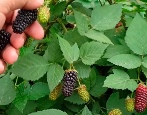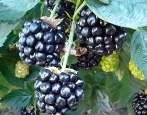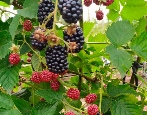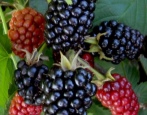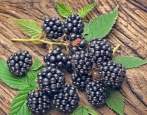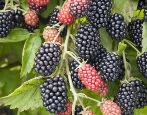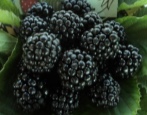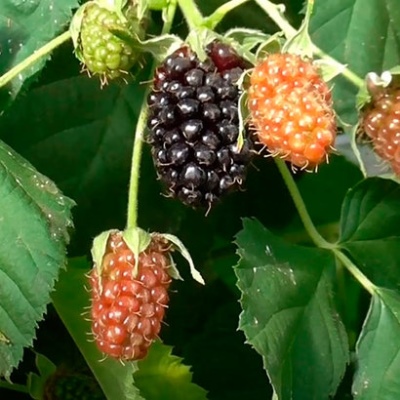
- Authors: USA, C. Finn
- Taste: dessert, with raspberry and cherry undertones
- Scent : there is
- The presence of thorns: No
- Tasting assessment: 4,7
- Berry weight, g: 7,8-16
- Berry size: large
- Berry color: brown-burgundy, in section - reddish
- Fruiting period: July-August, extended up to 2 months
- Yield: 7.5 kg per bush, 16.7 t / ha
Blackberries are a very fragrant and healthy berry that is present in almost every summer cottage. The greatest demand among novice gardeners, as well as among farmers engaged in growing on an industrial scale, is the thornless varieties of blackberries, one of which is the new type Columbia Star.
Breeding history of the variety
Columbia Star is a new variety that was bred less than 10 years ago. It appeared thanks to the long-term work of American breeders, led by Chad Finn, who, by crossing NZ 9629-1 (New Zealand) with the Orus 1350-2 variety, received a completely new type of blackberry called Columbia Star, which surpasses many berries in taste.
Description of the variety
Blackberry Columbia Star is a shrub-shaped plant endowed with thick and powerful stems, the height of which can reach 4–5 m. As a rule, the bush consists of 7–9 stems with many lateral branches. During the flowering period, the bush is strewn with green leaves and white flowers. A characteristic feature of the variety is the absence of thorns and an incredible aroma emanating from the berries.
Ripening terms
Due to the fact that this blackberry variety is grown quite recently on the territory of our country, it is rather difficult to talk about the clarity of the timing of flowering and fruiting. In the southern regions, active flowering occurs in mid-late June, while in others - a little later. On average, the fruiting period stretches for 4-6 weeks and falls in July-August.
Growing regions
It is possible to breed and grow this blackberry variety in different regions, be it the central part of the country or the southern one. The Urals, the Volga region and Eastern Siberia, where temperature fluctuations and strong gusts of wind are characteristic, can become difficult zones for this berry.
Yield
The yield of this variety is moderate. A high yield is observed 2-4 years after planting. On average, 7.5 kg of berries can be harvested from each bush per season. Active fruiting begins from the second year of life of the blackberry bush.
Berries and their taste
The huge advantage of Columbia Star berries is their amazing taste, which is dominated by sweetness, juiciness and richness. Compared to other berries, the Columbia Star blackberry is a combination of cherry and raspberry flavor. The berry has an elongated shape (length up to 4 cm) and considerable weight: the weight ranges from 8-16 g. The color of the berries is brown-burgundy, and inside is bright red. Due to their high fleshiness and density, the fruits tolerate long-term transportation.
Growing features
Before planting a plant, you need to choose the right place, prepare it. The main thing is to comply with the planting time. There are no problems with cultivation, since the plant is resistant to drought and frost, down to -14–16 °.
Site selection and soil preparation
The site for planting blackberries should be well lit by the sun and be protected from strong winds and drafts. It is better that this is an insignificant hill, and not a lowland, in which water constantly stands. The best option is to land along the fence.As for the soil, it must be breathable, without surface crust. The ideal type is loam, as well as loose soils with a good organic matter content and low acidity.
Pruning
Pruning frozen and diseased branches is done in autumn and spring. In addition, you need to regularly get rid of dry branches, giving the opportunity to appear new, young.
Watering and feeding
After planting, the plant needs to be watered frequently: several times a week, pouring 5–7 liters of water under each bush. In the interim, it is necessary to water several times a month, and in severe drought, provide a light irrigation system.
In the spring, blackberries are fertilized with nitrogen, and after flowering, a whole mineral complex is applied. In autumn, phosphorus-potassium fertilizers are applied.
Frost resistance and preparation for winter
Despite the frost resistance, blackberry bushes must be insulated for the winter. For this, the branches are removed from the supporting structures and laid on the ground, and covered with agrofibre on top.
Diseases and pests
This variety is resistant to diseases and pests, but prevention must be carried out. The best prevention is spraying in the fall. It is extremely rare for a plant to be exposed to anthracnose, rust and powdery mildew.
Reproduction
This variety is propagated by many options: using seeds or layering, by dividing the bush, as well as using green cuttings and apical shoots.
Review overview
Columbia Star is one of the tastiest blackberries, according to numerous commercial berry farmers. It is unpretentious in care, retains its presentation for a long time, quickly adapts to climatic conditions.
For summer residents, this variety is attractive for its resistance to droughts, as well as the fact that the berry can be consumed fresh and prepared (frozen, preserved).
